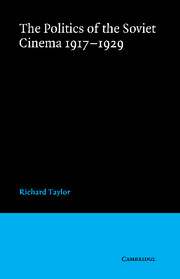Book contents
- Frontmatter
- Contents
- Preface
- Acknowledgements
- Note on transliteration
- Abbreviations
- 1 The pre-history of the Soviet cinema
- 2 The Bolsheviks, propaganda and the cinema
- 3 Revolution and Civil War
- 4 The disorganisation of organisation: the early twenties
- 5 The organisation of disorganisation: the later twenties
- 6 The Party takes control
- 7 Theory and film
- 8 Conclusions
- Notes
- Bibliography
- Index
8 - Conclusions
Published online by Cambridge University Press: 07 October 2011
- Frontmatter
- Contents
- Preface
- Acknowledgements
- Note on transliteration
- Abbreviations
- 1 The pre-history of the Soviet cinema
- 2 The Bolsheviks, propaganda and the cinema
- 3 Revolution and Civil War
- 4 The disorganisation of organisation: the early twenties
- 5 The organisation of disorganisation: the later twenties
- 6 The Party takes control
- 7 Theory and film
- 8 Conclusions
- Notes
- Bibliography
- Index
Summary
The cinema, like every art, cannot be apolitical.
Party Conference resolution, 1928.It was not then until 1928–9 that the Soviet cinema was brought under the effective control of the Party. The ‘cultural revolution’ that accompanied the First Five Year Plan was to ensure that what Stalin had described as ‘the greatest means of mass agitation’ was in the 1930s and 1940s to become a mouthpiece for Stalinist orthodoxy. The meaning of the 13th Party Congress resolution of 1924 was reinforced in the resolutions of the Party Conference on the Cinema of March 1928:
The cinema should be a weapon of the proletariat in its struggle for hegemony, leadership and influence in relation to the other classes, it ‘should be, in the hands of the Party, the most powerful medium of communist enlightenment and agitation’…
In the period of socialist construction the cinema should be the most powerful weapon for the deepening of the class-consciousness of the workers, for the political re-education of all the non-proletarian strata of the population, and above all the peasantry.
That control of the cinema, so that it could be employed as a weapon of political and class warfare, had long been an aim of the Party is undeniable; that that control of the cinema had still not been achieved by the spring of 1928 is perhaps surprising, but the path towards such control had been long and tortuous.
- Type
- Chapter
- Information
- The Politics of the Soviet Cinema 1917–1929 , pp. 152 - 157Publisher: Cambridge University PressPrint publication year: 1979



